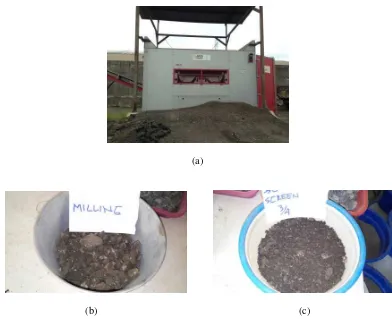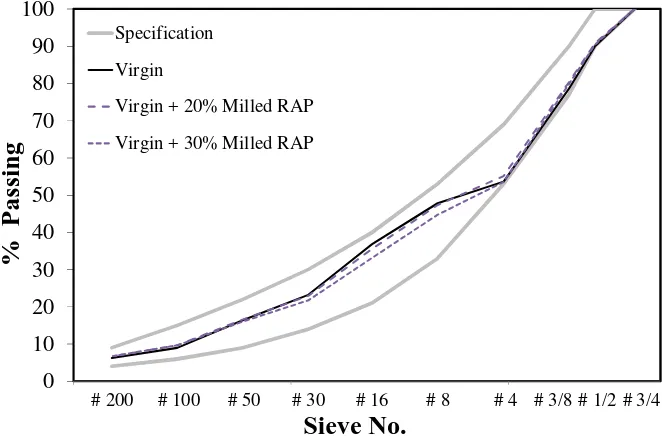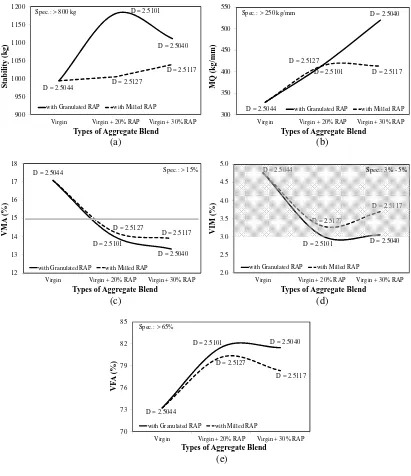EFFECT OF DIFFERENT FRACTAL DIMENSION OF VARIOUS RAP BLENDS Jalan Prof. Sudarto, SH., Tembalang
Semarang, Indonesia 50275 Tel./Fax.: +62-24-7471379 Email: [email protected]
ABSTRACT
Today, the use of reclaimed asphalt pavement (RAP) as pavement materials is increases. This is driven by the awareness of many agencies to give more contribution on applying green technology in road pavement structure, by reducing un-renewable materials in the mixture of overlay. However, many obstacles were encountered, especially the amount of RAP materials allowed for being used due to the complexity nature of RAP materials, such as high variation of RAP aggregate gradation and ageing asphalt material, that will lead to unpredictable performance of the mixtures. In practice, RAP materials may be obtained in different forms, i.e. milled RAP and granulated RAP, as a result of grinding process of milled RAP. This research was initiated by the effort to analyze the effect of amounts and forms of RAP material on the performance of the mixture. To evaluate the variation of RAP aggregate gradation fractal theory is proposed to be use in this study. It is expected that this theory could help explain better the characteristics of gradation of the mixture. The mixtures with virgin aggregate and milled or granulated RAP material blend were compared with 100% virgin material mixture and subject to Marshall-property assessment. The study showed that the randomized nature of RAP could produce unpredictable grading condition of a gradation of virgin aggregate – RAP blend. The comparison of gradation of this blend to the gradation of virgin aggregate will assist to find out the grading condition. Moreover, the use of granulated RAP in the aggregate blend could help to improve the stability and rigidity of the mixture, even though it will sacrifice the voids. The use of lesser amount of RAP in the aggregate blend (less than 20% in this case) could be considered as a better option.
Keywords: RAP, aggregate gradation, fractal theory
1. INTRODUCTION
asphalt. Reclaimed Asphalt Pavement (RAP) is a pavement that had been critically damaged which then dug up and crushed into a sort of aggregate (Sunarjono, 2012). The recycling process that utilizes RAP as a constituent material of new job mix formula is one form of green technology because besides by reducing the use of non-renewable materials, RAP can also reduce the greenhouse effect resulting from the production process of aggregate and Asphalt.
An understanding of the percentage of RAP used in a mixture is generally obtained from experimental testing in laboratory (Celauro et al, 2010; Reyes-Ortiz, 2012; Hussain and Qiu, 2013; Poulikakos et al., 2014). In practice, RAP materials may be obtained from milling process of road sections with different road distresses. It is known that each distress is a result of combination of factors, such as lack of foundation-layer support, high traffic load, low quality of material, and so on. RAP materials also can be found in different forms, i.e. milled RAP and granulated RAP, as a result of grinding process of milled RAP. Those experiments and practices resulted in different findings for the presentation of RAP that leads to different RAP aggregate gradation. This occurs due to differences in characteristics and complexities of RAP material itself.
This research is initiated by the effort to analyze the effect of amounts and forms of RAP material (milled or granulated) on mixture performance. To evaluate the variation of RAP aggregate gradation, fractal theory was proposed to be use. Fractal theory is a manner to describe quantitatively the geometric complexity and space filling capability of the object. It is expected that this theory could help explain better the characteristics of gradation of the mixture.
2. FRACTAL DIMENSION
Fractal geometry is used to describe the morphology of irregular forms by characterizing their structure in one-, two-, and three-dimensional space using the fractal dimensions D1, D2, and D3
(Tang et al., 2001). The one dimensional fractal dimension D1 is determined on the basis of measured maximum lengths of particles of suspension L and their perimeter P using the proportion:
P
∝
L
D1 (1)The two – dimensional fractal dimension D2 can be found from the relationship:
A
∝
L
D2 (2)where A is the surface of particles of maximum length L. The three-dimensional fractal dimension D3
that characterize the volume V of particles described by the proportion:
V
∝
L
D3 (3)For an aggregate gradation, as the distribution of the aggregate is studied by the fractal dimension, it will get the following equation:
(4)
in which:
P(r) = aggregate passing rate
rmax, rmin = maximum and minimum size of particle
ܲሺݎሻ=
ݎ3−ܦ
−ݎ݉݅݊
3−ܦ
ݎ݉ܽݔ
3−ܦ
−ݎ݉݅݊
ܲሺݎሻ=ܯܯݎ =ܸܸݎ =൬ r rmax
൰3−D
݈݊ ܯݎ
ܯ =ሺ3 −ܦሻ ݈݊ ݎ+ܽ
V =ܯ ρ
ܲሺݎሻ=൬ ݎ rmax൰
3−ܦ
Different grading curve can be obtained in accordance with the D value that has been given, and variations in the D value will determine the type of grading curve. rmin then can be ignored as the small
of its value, subsequently the equation (Weizhi et al., 2012):
(5)
If M is the total mass of the aggregate grading and ρ is aggregate density, then volume:
(6)
From equation (5), and (6) we will get the equation (7):
(7)
in which:
Mr = Total fractal aggregate with a particle size of less than R particles.
The method used to calculate the fractal dimension of the aggregate gradationis to calculate the slope in accordance to a double logarithmic coordinates of ln (Mr / M) and ln r by using linear regression. At this stage, the fractal dimension is obtained from the slopes and the correlation coefficient (R) can also be used as the basic parameters, as follows
(8)
Then D can be calculated from equation (8):
D = 3 - b (9)
From this research, fractal dimension can reflect the characteristics of gradation, and subsequently can be be used to optimize the design mixture of asphalt.
3. RESEARCH METHODOLOGY
This research was intended to evaluate the influence of aggregate gradation in the means of fractal dimension towards the performance of asphalt mixture. To do so, the following steps were conducted: (i) Preparing the materials: virgin asphalt, i.e. asphalt Pen 60/70, and aggregate were collected
from local supplier, while recycle materials, i.e. recycled asphalt pavement (RAP), were collected from contractor PT. Jaya Konstruksi. The contractor has a routine schedule to mill the old pavement surface at around Jakarta. In order to determine the effect of different fractal dimension of various rap blends on mixture performance, two different procedures were used in the present study. The first procedure (or procedure A) was to use milled RAP from the milling operations on site as it is; while the second one (or procedure B) was to crushed them into smaller pieces using granulator device and sieve the material on the ¾-inch sieve. The illustrations of the device, milled, and granulated RAP are depicted in Figure 1.
(a)
(b) (c)
Figure 1: (a) granulator device; (b) milled RAP; and (c) granulated RAP
To ensure that virgin materials were as expected, some standard tests, such as penetration test, softening point, and so on (for asphalt) and sieve analysis, specific gravity of aggregate, and so on (for aggregate), were applied. The results of the tests should conform to the specification of materials of Indonesian standard (Indonesia Directorate General of Highway, 2010).
(ii) Extracting RAP materials: milled and granulated RAP were extracted and sieved using standard sieves to obtain the gradation of its materials. In addition, the asphalt content of the RAP could be determined after extraction process. The extraction should obtain the composition of asphalt and aggregate in RAP.
(iii) Preparing asphalt mixtures: Asphalt mixture consisted of virgin asphalt and aggregate was prepared. It is necessary to determine the optimum asphalt content and aggregate gradation of this mixture, and use them as a reference for the rest of the mixtures. Another mixture prepared in this study was mixture that consisted of RAP material and additional virgin asphalt and aggregate. Two different procedures were proposed in this study. For procedure A, virgin aggregate – milled RAP, two blends were prepared each with 20% and 30% RAP content respectively in the mixture. As well with procedure B, virgin aggregate – granulated RAP, two blends were also prepared with RAP content of 20% and 30% on the mixture. The amount of virgin asphalt added was depended on the difference between the optimum asphalt content and the asphalt content of RAP after extraction (in step ii).
(iv) Two evaluation processes were conducted in this study: (a) evaluation of aggregate gradation using chart and fractal theory, and (b) evaluation of the effect of fractal dimension on Marshall properties.
4. RESULTS AND ANALYSIS
In this section, it is important to highlight the test results of material used in this study, as depicted in Tables 1 – 3 for coarse aggregate, fine aggregate and asphalt, respectively. As shown in the tables, all results give the conformity to the requirements stated in Indonesia Directorate General of Highways’ specification.
Table 1: Properties of Coarse Aggregate (ASTM, 2003)
No Aggregate properties Test Method Requirements Results
1 Affinity to asphalt (%) ASTM D1664-80 > 95 99
2 Abrasion (%) ASTM C131-06 < 40 19.42
3 Water Absorption (%) ASTM C127 – 07 < 3 1.51
4 Specific gravity ASTM C127 – 07 > 2.5 2.62
5 Flakiness and Elongation index (%) ASTM D4791-10 < 25 6.6
Table 2: Properties of Fine Aggregate (ASTM, 2003)
No Aggregate properties Test Method Requirements Results
1 Water Absorption (%) ASTM C127 – 07 < 3 2.02
2 Specific gravity ASTM C127 – 07 > 2.5 2.65
3 Sand Equivalent (%) ASTM D2419-14 > 60 81.20
Table 3: Properties of Asphalt (ASTM, 2003)
No Aggregate properties Test Method Requirements Results
1 Specific gravity ASTM D70 – 09e1 ≥ 1 1.04
2 Penetration (0.1 mm) ASTM D946 – 09a 60 – 70 67.5
3 Softening Point (º C) ASTM D36– 09 ≥ 48 49.5
4 Loss of Weight (TFOT) (%) ASTM D2872 - 04 ≤ 0.4 0.18
Figures 2 and 3 present the aggregate gradations of two different procedures, procedure A and procedure B respectively. Each procedure consisted of two blends with 20% and 30% of RAP content, and both procedures were compared to the gradation of virgin aggregate (the one with bold black line) – as the reference gradation. To ensure that all gradation could give a good support to the mixture performance, all gradation above should lay in the grading envelope (shown by grey bold lines), as defined in Indonesia Directorate General of Highways’ specification.
0
Figure 2: Procedure A (Gradations of Virgin Aggregate - Milled RAP Blend)
0
Figure 3: Procedure B (Gradations of Aggregate - Granulated RAP Blend)
This kind of situation cannot be developed systematically due to the randomized nature of RAP composition. Although similar amount of RAP (either 20% or 30% of both procedures) was added into the aggregate blend, there was no guarantee that it will produce similar gradation.
In addition, even though the figure of aggregate gradation could describe more detail about the percentage of passing of each sieve number, however, a quantitative manner sometimes is more useful to assist one in determining whether the gradation is coarser or finer. To do so, fractal dimension D of all aggregate gradations was calculated in the study, and it was depicted in Table 4.
with slightly different offset. Asphalt Recycling and Reclaiming Association (ARRA) suggested that the range of D (determined from some projects and researches) was from 2.29 to 2.69 (Jia and Ye, 2010). It means that all mixtures with different types of aggregate blend could conform to the range.
Table 4: Fractal Dimension and Coefficient of Determination of Mixtures with Different Types of Aggregate Blend
Types of Aggregate Blend D R2
According to Table 4 and Figure 4, the following analyses could be made.
(1) It is known that the finer gradation was indicated by higher values of D. To explain the value of D of gradation of virgin aggregate – RAP blend, the D of virgin aggregate gradation was employed as the basis of comparison/reference. It needs to be highlighted that although some part of gradation for procedure B with 20% RAP blend was laid above the reference line unlike other mixtures (Figures 2 and 3), it did not reflect that the gradation was coarser or finer. Whilst these circumstances can be explain with the value of D of the gradation (Table 4). It was inferred that all blends between virgin and RAP would produce finer gradation, except for procedure B with 30% RAP content in the blend. The evaluation of whether the gradation is finer or coarser could help the contractor to determine the amount of virgin asphalt added into the mixture.
(2) Figure 4 shows the Marshall properties of mixtures with different aggregate blends. The solid line represented the properties of the mixtures with virgin aggregate – granulated RAP blend, while the dash one denoted the properties of the mixtures with virgin aggregate – milled RAP blend. Fractal values also added in the chart to enable one analyzing the effect of D on Marshall properties.
It can be showed in the figure that fractal dimension is only a measure to characterize the aggregate gradation quantitatively. An asphalt mixture is a combination between asphalt and aggregate, therefore the Marshall properties of the mixture were contributed by the properties of both materials. For example, fine aggregate has higher asphalt absorption than the coarse one (see Tables 1 – 2), consequently with similar asphalt content, a mixture with higher content of fine aggregate (as mixtures with milled aggregate in this case) will be more difficult to be compacted and this will leads to lower stability and VFA (see Fig. 4a and 4e).
The use of RAP in the mixture means that there is a certain amount of stiffer and less visco-elastic asphalt inside the aggregate blend. The presence of this kind of asphalt in the mixture can increase the rigidity of the mixture (as presented by higher Marshall Quotient/MQ values, see Fig. 4b), but on the other hand, it causes the mixtures become lack of voids (see the comparison between properties of mixtures with virgin aggregate and blend of virgin aggregate and RAP in Figures 4a and 4c).
900
Virgin Virgin + 20% RAP Virgin + 30% RAP
S
Virgin Virgin + 20% RAP Virgin + 30% RAP
M
Virgin Virgin + 20% RAP Virgin + 30% RAP
V
Virgin Virgin + 20% RAP Virgin + 30% RAP
V
Virgin Virgin + 20% RAP Virgin + 30% RAP
V
Figure 4: Marshall Properties of Mixture with Different Types of Aggregate: (a) Stability; (b) Marshall Quotient; (c) VMA; (d) VIM; and (e) VFA
5. CONCLUSIONS
This study aimed to evaluate the use of different forms of RAP in the asphalt mixture. For this purpose, a quantitative manner, i.e. fractal dimension D, was adopted in this study, as a complementary of aggregate gradation chart. The use of D in the gradation analysis then was further utilized to evaluate the Marshall properties of the mixture. The results showed that there is no obvious guideline available to assist one in determining what the grading condition of a gradation of virgin aggregate – RAP blend, except the use of gradation of virgin aggregate as reference gradation. Moreover, the use of granulated RAP in the aggregate blend could help to improve the stability and rigidity of the mixture, even though it will sacrifice the voids. The use of lesser amount of RAP in the aggregate blend (less than 20% in this case) could be considered as a better option.
6. ACKNOWLEDGEMENT
This research was supported by a grant of research provided by Faculty of Engineering Diponegoro University. Gratitude was also extended to PT. Jaya Konstruksi for the support of this research by providing RAP materials.
7. REFERENCES
ASTM, 2003. American Society for Testing and Materials Standard Book, West Conshohocken, PA, USA.
Celauro, C., Bernardo, C., Gabriele, B., 2010. Production of Innovative, Recycled and High-Performance Asphalt for Road Pavements. Resource, Conservation and Recycling, 54: 337– 347.
Chandra, R., Veeraragavan, A., Krishnan, J.M., 2013. Evaluation of Mix Design Methods for Reclaimed Asphalt Pavement Mixes with Foamed Bitumen, Procedia - Social and Behavioral Sciences 104: 2 – 11.
Hussain, A., Qiu, Y.J., 2013. Effect of Reclaimed Asphalt Pavement on the Properties of Asphalt Binders, Procedia Engineering, 54: 840–850.
Indonesia Directorate General of Highway, 2010. Specification of Hot Mixed Asphalt, Jakarta, Indonesia.
Jia, X. and Ye, F., 2010, Evaluation of Gradation of RAP Based on Fractal Theory, Paving Materials and Pavement Analysis: 51-57, doi: 10.1061/41104(377)7
Kaura, K., Swamyb, A.K., Das, A., 2013. Constituent Proportioning in Recycled Asphalt Mix with Multiple RAP Sources, Procedia-Social and Behavioral Sciences 104: 21– 28.
Poulikakos, L.D., Santos, S.D., Bueno, M., Kuentzel, S., Hugener, M., Part, M.N., 2014. Influence of Short and Long Term Aging on Chemical, Microstructural and Macro-mechanical Properties of Recycled Asphalt Mixtures. Construction and Building Materials 51: 414–423.
Reyes-Ortiz, O., 2012. Evaluation of Hot Mix Asphalt Mixtures with Replacement of Aggregates by Reclaimed Asphalt Pavement (RAP) Material. Procedia – Social and Behavioral Sciences, 53: 379 – 388.
Sunarjono, S., 2012. Engineering Use of Reclaimed Aphalt Pavement for Road Construction Preservation, National Symposium RAPI XI FT UMS-2012, ISSN : 1412-9612 (in Bahasa Indonesia).
Tang, S., Ma, Y., Shiu, C., 2001. Modelling the Mechanical Strength of Fractal Aggregates. Colloids and Surfaces A, Physicochemical and Engineering Aspects, 180: 7–16.
Weizhi, D., Xuedong, G., Liang, G., 2012. Study on the Fractal Gradation Optimization of ATB-25, Proceedings of the 2nd International Conference on Electronic & Mechanical Engineering and Information Technology, China.




